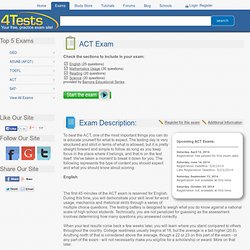

Outdoor Leadership Programs. U.S. College Admissions. College admissions in the United States refers to the process of applying for entrance to institutions of higher education for undergraduate study at one of the nation's 2,675[2] four-year nonprofit schools.

Generally, the college search begins in the student's junior year of high school with most activity taking place during the senior year, although students at top high schools often begin the process during their sophomore year. In addition, there are considerable numbers of college students who transfer, as well as adults older than high school age who apply to college. Overview[edit] Millions of high school students apply to college each year.
Fewer than half of all students entering college graduate in four years[5] and slightly over half graduate from college during their lifetimes.[5] College admissions take considerable time and involves multiple steps, deadlines and choices, including fees, essays, college visits, and interviews. Participants[edit] Students[edit] Parents[edit] ACT. ACT, Inc. says that the ACT assessment measures high school students' general educational development and their capability to complete college-level work with the multiple choice tests covering four skill areas: English, mathematics, reading, and science.

The optional Writing Test measures skill in planning and writing a short essay.[15] Specifically, ACT states that its scores provide an indicator of "college readiness," and that scores in each of the subtests correspond to skills in entry-level college courses in English, algebra, social science, humanities, and biology.[16] According to a research study conducted by ACT, Inc., in 2003, a relationship was found between a student's ACT composite score and the possibility of he or she earning a college degree.[17] Most colleges use ACT scores as only one factor in their admission process. The ACT is more widely used in the Midwestern, Rocky Mountain, and Southern United States, while the SAT is more popular on the East and West coasts. ACT Practice Exam. To beat the ACT, one of the most important things you can do is educate yourself for what to expect.

The testing day is very structured and strict in terms of what is allowed, but it is pretty straight forward and simple to follow as long as you keep focus in the place where it belongs, and that is on the test itself. We've taken a moment to break it down for you. The following represents the type of content you should expect and what you should know about scoring. English The first 45 minutes of the ACT exam is reserved for English. When your test results come back a few weeks later, you will learn where you stand compared to others throughout the country. Math Math scores tend to improve throughout one's secondary education pathway, so it pays to take the ACT more than once. The battery itself consists of 60 questions and a 60-minute time limit. Reading. ACT Practice Questions. Getting into the right college can determine a lot about your life and career.

Well prepared exam takers rely on an ACT Test Study Guide to help them get ready for the test, while others may prefer ACT Test Flashcards. Don't let procrastination stand in the way of your success. The American College Testing Test (ACT) is a college admissions examination taken by high school-aged students to determine their readiness for college. Approximately the same numbers of students take the ACT as the Scholastic Assessment Test (SAT) as the ACT has increased in popularity in recent years. Results are accepted by all four-year colleges and universities in the United States as part of the admissions process. The regular ACT consists of four sections: English, Mathematics, Reading, and Science. There is also an option to take what is called the ACT Plus Writing which consists of the same sections and also 30-minute writing test. SAT. This article is about the college admission test in the United States.

For the exams in England colloquially known as SATs, see National Curriculum assessment. The SAT is a standardized test widely used for college admissions in the United States. It was first introduced in 1926, and its name and scoring have changed several times, being originally called the Scholastic Aptitude Test, then the Scholastic Assessment Test, then the SAT Reasoning Test, and now simply the SAT.